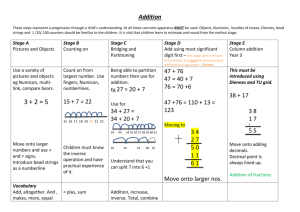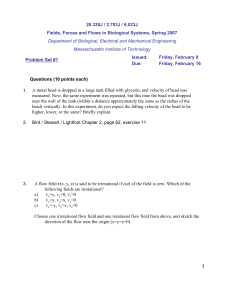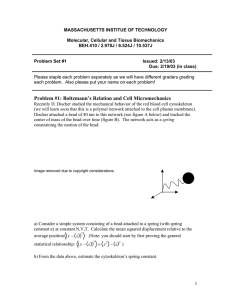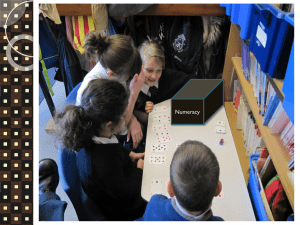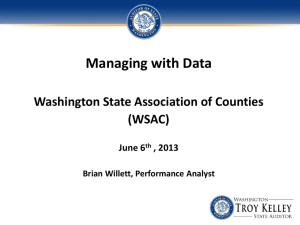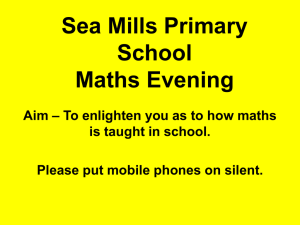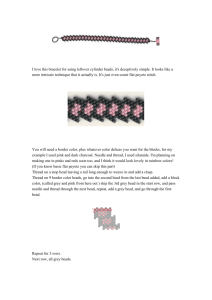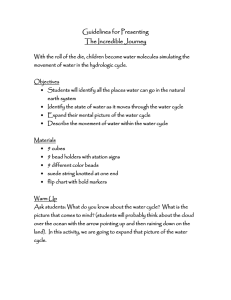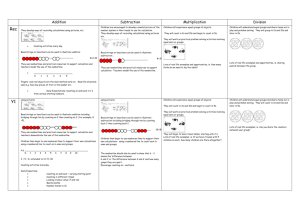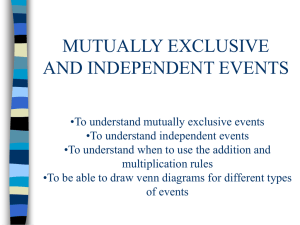Calculations in Year 1
advertisement
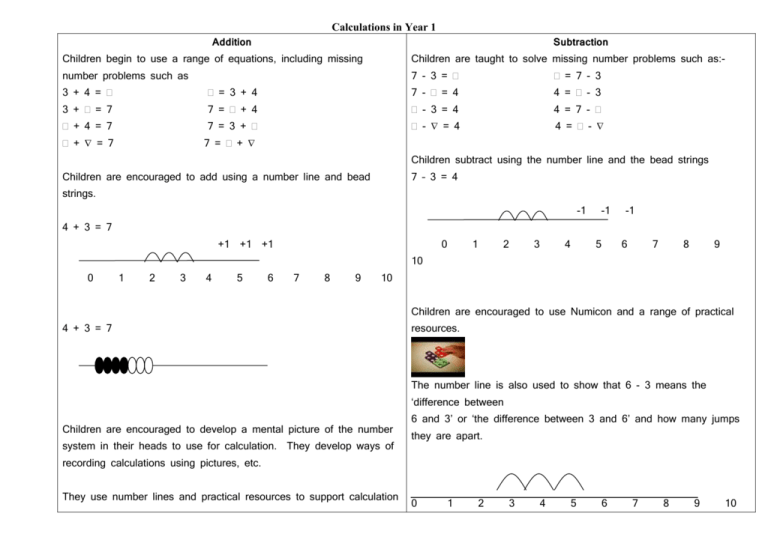
Calculations in Year 1 Addition Subtraction Children begin to use a range of equations, including missing Children are taught to solve missing number problems such as:- 3 + 4 = 7 - = 4 number problems such as 3 + = 7 7 - 3 = = 3 + 4 7 = + 4 + 4 = 7 4 = 7 - - = 4 7 = + 4 = - Children subtract using the number line and the bead strings Children are encouraged to add using a number line and bead 7 – 3 = 4 strings. -1 4 + 3 = 7 0 4 = - 3 - 3 = 4 7 = 3 + + = 7 = 7 - 3 +1 +1 +1 1 2 3 4 5 6 7 8 9 10 4 + 3 = 7 10 0 1 2 3 4 -1 5 -1 6 7 8 9 Children are encouraged to use Numicon and a range of practical resources. The number line is also used to show that 6 - 3 means the ‘difference between Children are encouraged to develop a mental picture of the number system in their heads to use for calculation. They develop ways of 6 and 3’ or ‘the difference between 3 and 6’ and how many jumps they are apart. recording calculations using pictures, etc. They use number lines and practical resources to support calculation 0 1 2 3 4 5 6 7 8 9 10 and teachers demonstrate the use of the number line. Children are encouraged to use practical objects such as bead Children then begin to use numbered lines to support their own calculations - using a numbered line to count back in ones. 13 – 5 = 8 -1 strings, bricks and Numicon to count on. 0 All calculations where possible are grounded in practical and relevant activities where the children can see purpose. 1 2 3 4 5 6 7 8 -1 9 -1 -1 -1 10 11 12 13 14 15 Bead strings or bead bars are used to illustrate subtraction including bridging through ten by counting back 3 then counting back 2. 13 – 5 = 8 Multiplication Division Children are introduced to missing number problems as in addition and subtraction involving the multiplication symbol. Children will experience equal groups of objects and will count in 2s and 10s and begin to count in 5s. They will work on practical problem solving activities involving equal sets or groups. 5 5 Children should be introduced to missing number problems as in addition and subtraction involving the division symbol. Children will understand equal groups and share items out in play and problem solving. They will count in 2s and 10s and later in 5s. 6 2 can be modelled as: Sharing – 6 sweets are shared between 2 people. How many do 5 they have each? 0 1 2 3 4 5 6 7 8 9 10 11 12 13 14 15 Division can be demonstrated using a number line; Children will learn to multiply on a number line and on a bead bar: 3 times 5 is 5 x 3 = 5 + 5 + 5 5 + 5 + 5 = 15 5 or 3 lots of 5 5 or 5 x 3 5 12 ÷ 2 = 6 The first number is the number they end at and the second number is how many are in each jump. Commutativity Children should know that 3 x 5 has the same answer as 5 x 3. This can also be shown on the number line. 5 0 1 2 3 5 3 4 5 3 6 7 3 Grouping – There are 6 sweets. How many people can have 2 each? (How many 2’s make 6?) 5 8 9 10 11 12 13 14 15 3 3 0 2 4 6 OR Children should be taught to calculate using arrays: 0 4 x 2 or 4 + 4 2 x 4 or 2 + 2 + 2 2 4 6 Children should be given as many opportunities as possible for practical sharing using everyday items.
